What It’s Like to Visit the Galapagos Right Now
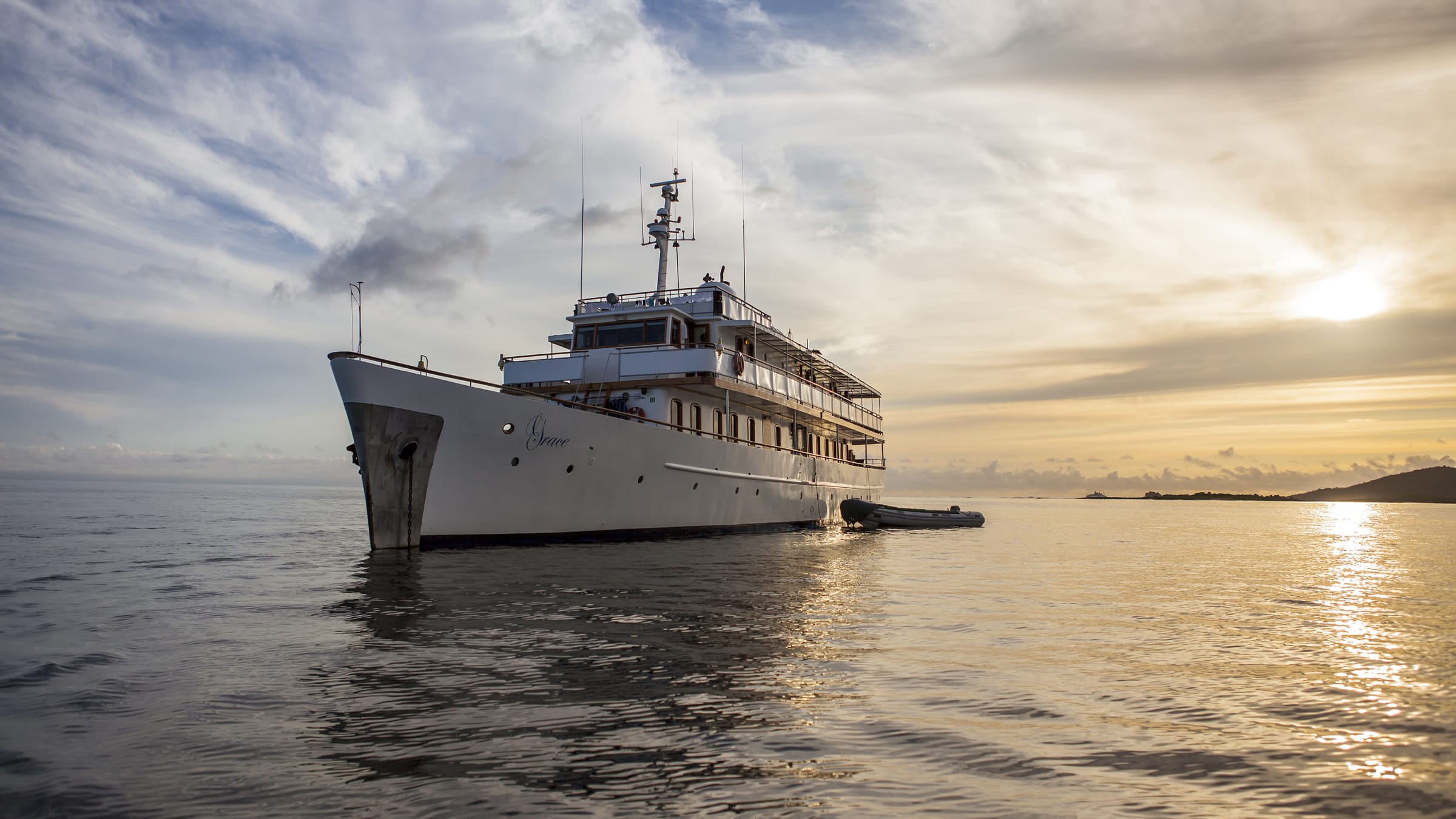
Quasar
Isolated in the Pacific, teeming with wildlife but lacking a large human footprint, the islands might be the perfect pandemic vacation.
Floating down a beryl blue lagoon that knifed into a post-apocalyptic black volcanic landscape, I started to have the strange sensation of being followed.
It’s not an uncommon feeling for me while snorkeling—I have a crippling, irrational fear of large sharks. (Days earlier I’d made sure there was always somebody snorkeling in front, behind, and to my left and right until I realized a shark could and would just come from below.) But quickly reassuring myself there was no way a shark was in here, I whipped my head around.
A glimpse was all I got, and then a swirl of bubbles and a flash of flippers as two sea lions disappeared.
For the next 30 minutes they would trail me all the way down the lagoon, sometimes darting off when I glanced their way and sometimes zooming close to whirl around me and eerily gaze at me with their big brown eyes.
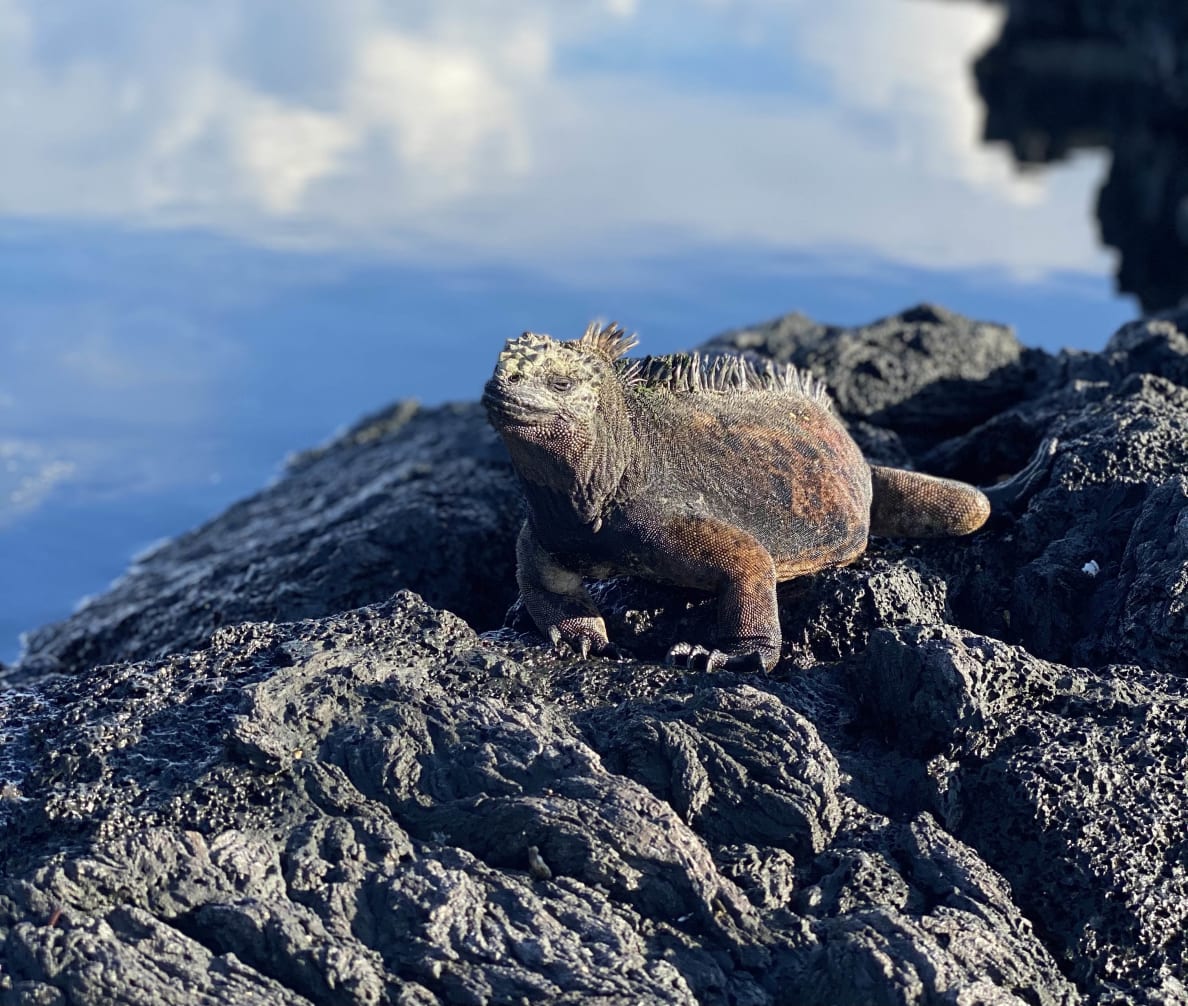
Will O'Connor/The Daily Beast
I was in the upside-down world of the Galapagos Islands. A land where blasé giant iguanas graze several feet under water and penguins hunt in subtropical mangroves. Here, birds not only stay put when you walk near them, but will often come closer to inspect you. Giant green sea turtles resting underwater along rock cliffs will be so carefree in your presence that they just might bang into you while carried to and fro by the swells. Meanwhile on land there are tortoises that grow up to 800 pounds. There are owls that hunt in broad daylight from the rocky ground and flightless cormorants with tiny wings that border on the absurd. And if you glance away from the watchful gaze of militant king angelfish staring you down, you just might catch a glimpse of a playful sea lion following you.
I visited the Galapagos by invitation of Quasar Expeditions, the adventure cruise company whose trips around the islands are perennially lauded. My longstanding desire to visit these islands made famous by Darwin coupled with a journalistic curiosity about what it was like to visit one of the handful of major destinations still open to international tourists meant I enthusiastically said yes.
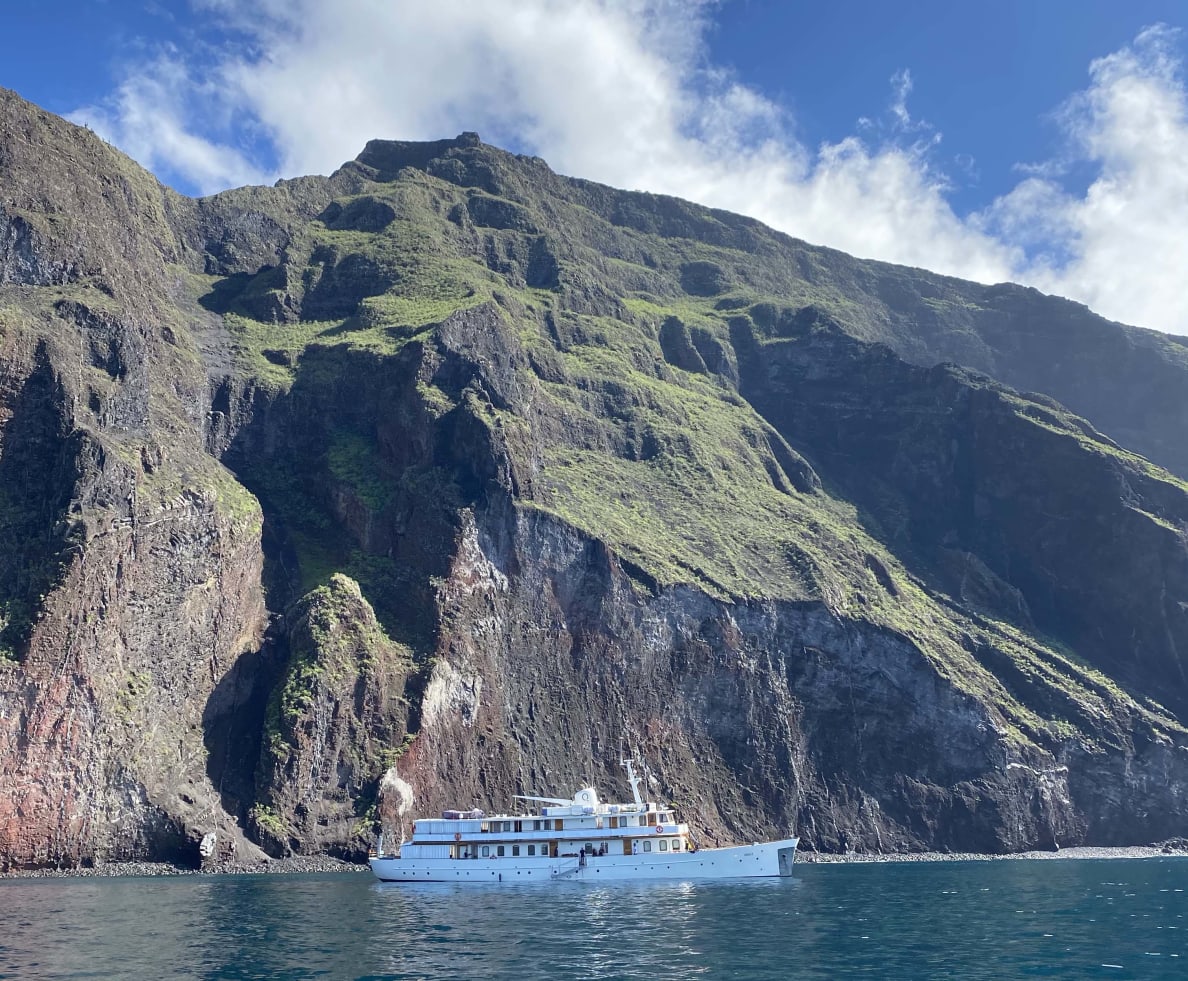
Will O'Connor/The Daily Beast
Quasar’s journeys are designed like a safari except home base is a ship instead of a game lodge, and mine took place aboard the Princess Grace, the 147-foot-long yacht, built in 1928, whose claim to fame is that it was given to Princess Grace of Monaco and her husband Prince Rainier as a wedding present by Greek shipping magnate Aristotle Onassis. The Grace was also conscripted by the Royal Navy during World War II and outfitted with guns. Later, after decades of languishing, she was rescued in the 1980s and nearly bought by Microsoft’s Paul Allen as a support ship for his mega-yacht. Luckily for Galapagos visitors, she was instead acquired by Quasar and outfitted for cruise expeditions. The rooms, while varying in size, are all comfortable and well-appointed and the Princess Grace suite is very elegant. (Perhaps the nicest surprise were the meals, which left no room for complaint.) The Grace holds 14 guests in addition to its crew.
The route goes for seven days and visits five of the islands: Santa Cruz, Genovesa, Santiago, Isabela, and Fernandina.
Each day included a mix of activities—nature walks to see birds, giant tortoises, lizards, and unique flora, as well as snorkeling, kayaking, and Avon inflatable rides for more wildlife spotting. In the evening, naturalist guides gave 45-minute talks designed to give depth to what we were seeing—the science of volcanos, convergent evolution, the threats the islands currently face, etc.
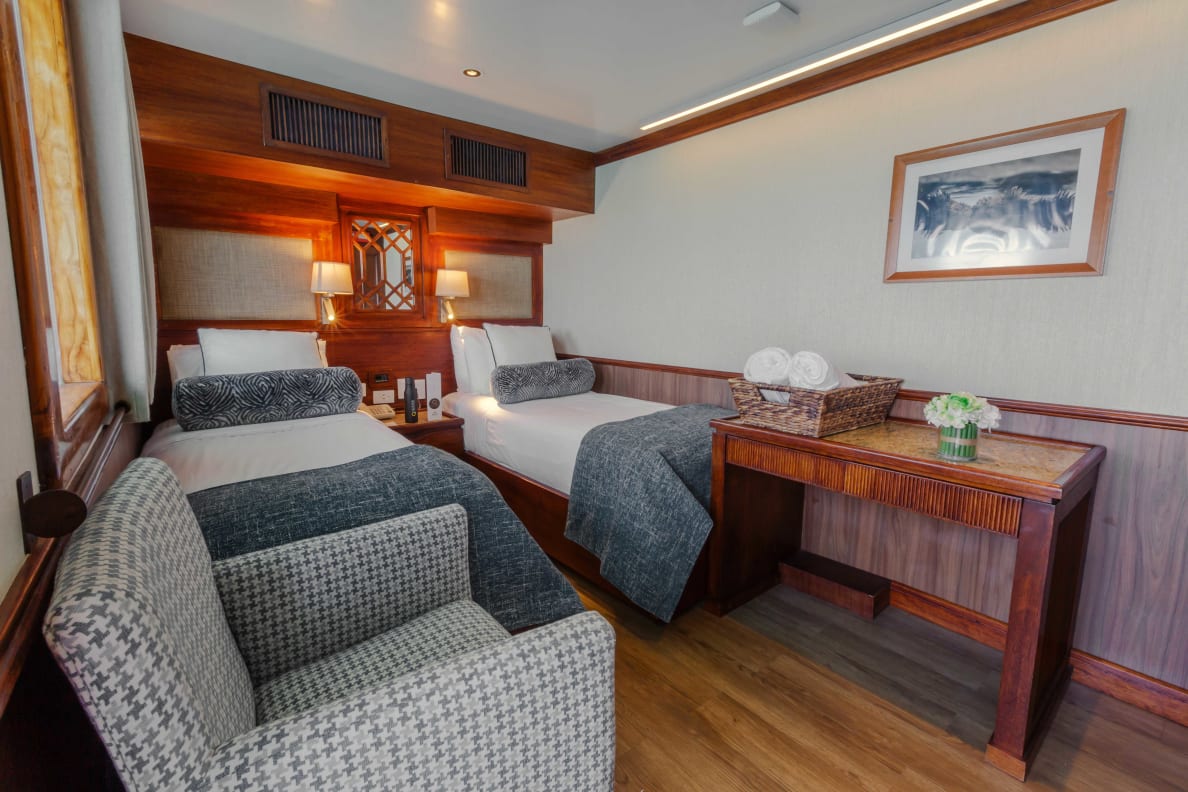
Courtesy Quasar
To visit the Galapagos, a province of Ecuador, you must have a negative PCR test taken no more than 10 days before entering the country. Then the Galapagos requires another test before you can enter the islands, which Quasar helped arrange (along with all the normal paperwork required to go).
In addition to the testing, virtually all the guests—mostly from the U.S.—had either been vaccinated, already had COVID, or self-isolated in some way before coming. (And then were tested again upon leaving if we were returning to the U.S.). In our entire time sailing from island to island, we saw only one other expedition vessel and one private charter, meaning we had all this nature to ourselves—a state of things likely to continue at least for the next few months.
The most incredible thing about the Galapagos isn’t the abundance of wildlife, although that is certainly a draw—it’s that the wildlife here by and large aren’t scared of you. When you’re out for a nature walk, for instance, juvenile boobies will stand in the middle of the path, stare at you, and possibly waddle up to you to get a closer look.
I never quite got used to millions of birds being utterly unafraid of a human presence.
And having the naturalist guides along (a requirement which also protects well-paid employment in the Galapagos) means you can ask any question that pops into your head about the creatures you’re seeing—predators, mating, weird trivia, or even if the way they’re looking at you means anything. And the guides on my trip, Roberto and Walter, brought the science to life in relatable, accessible ways.
“Red-footed boobies, they live in a mafia-controlled neighborhood,” explained Roberto one morning as we traversed a rocky landscape with scraggly bushes filled with nesting boobies as tens of thousands of wedge-rumped storm petrel pirouetted at the cliff’s edge behind us. In those same bushes were another set of birds, frigatebirds, that while magnificent flyers left me filled with pity for their pathetic mating ritual (the males inflate a giant red pouch, shimmy and shake and gobble whenever a female passes overhead hoping she’ll stop). “The frigatebirds are thieves,” our guide explained, and so we watched in Blue Planet-worthy awe as daring boobies raced to bring sticks or fish to their nests with frigates swarming them to steal them—exacting the price of doing business here. (Side note—while the blue-footed booby is world famous, I found the red-footed far more mesmerizing, with their bloody-looking feet and a particularly entrancing blue beak and eyes.)
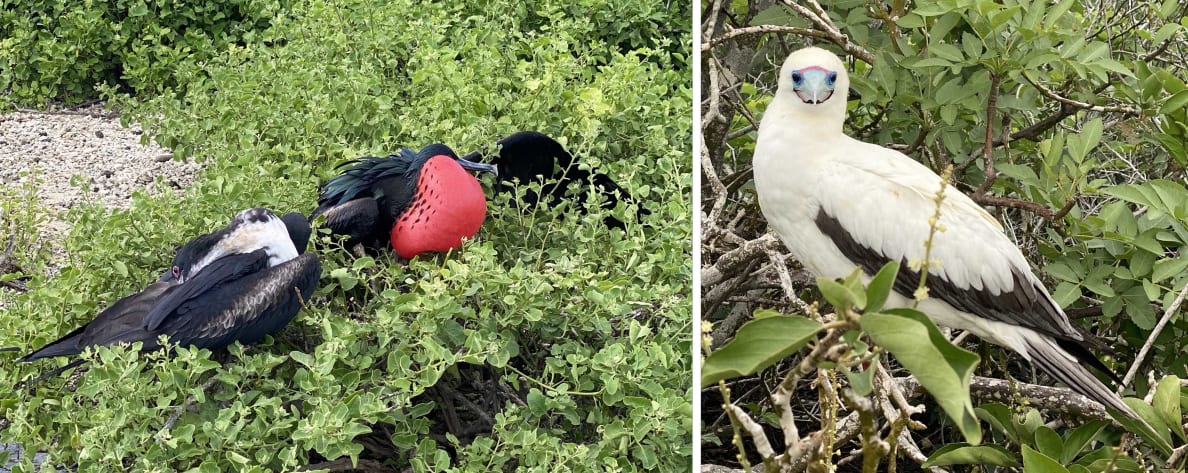
A frigatebird inflating himself to impress a female and red-footed booby
Will O'Connor/The Daily Beast
Yet while Darwin may have enjoyed, indeed made his name upon, the birds here, the unalloyed delight for me was to be found under water.
Along cliffs, in lagoons, or around rock islands off shore, there was so much to see that my only real regret from the trip was that I didn’t bring a GoPro or some kind of device for using your iPhone underwater. (Which meant that as of writing I’m trying not to bug one of the other guests too much who may have captured me blurting out, “Oh shit!” when one day I turned around after floating near a sea turtle to find myself face to face with a curious sea lion.)
There are black- and white-tip reef sharks, the occasional Galapagos shark, and hammerheads. One night we saw a tiger shark near the boat. There are marble, manta, and white-spotted eagle rays. A dazzling array of fish, from triggerfish to Moorish idols, concentric pufferfish and hieroglyphic hawk fish that aren’t nearly as hidden as they think.
And, sure, the penguins (second smallest in the world but farthest north) are a hot ticket because, well, they’re penguins in the tropics, but the flightless cormorants were my aquatic bird oddity of choice. The cormorants in the Galapagos have these vestigial wings and instead surface-dive (huge webbed feet) to catch the fish, lashing this way and that with their sensuous long necks. Their eyes are a milky blue, and it’s utterly bewitching to watch them operate. Plus, once on land, they stand there with their little useless wings outstretched. While they are in fact drying them, it’s almost as if they’re daring you to stare.
And speaking of staring—you will undoubtedly gawk at the surreal scene of giant iguanas blithely feeding on algae under the sea.
But for my money, the real winners are the sea lions. Perhaps it’s because of the comparisons a non-expert eye instinctively makes to dogs or the human traits we egotistically apply to their actions. But whatever the reason, the days when they were plentiful and their play was forward, those were the best days.
